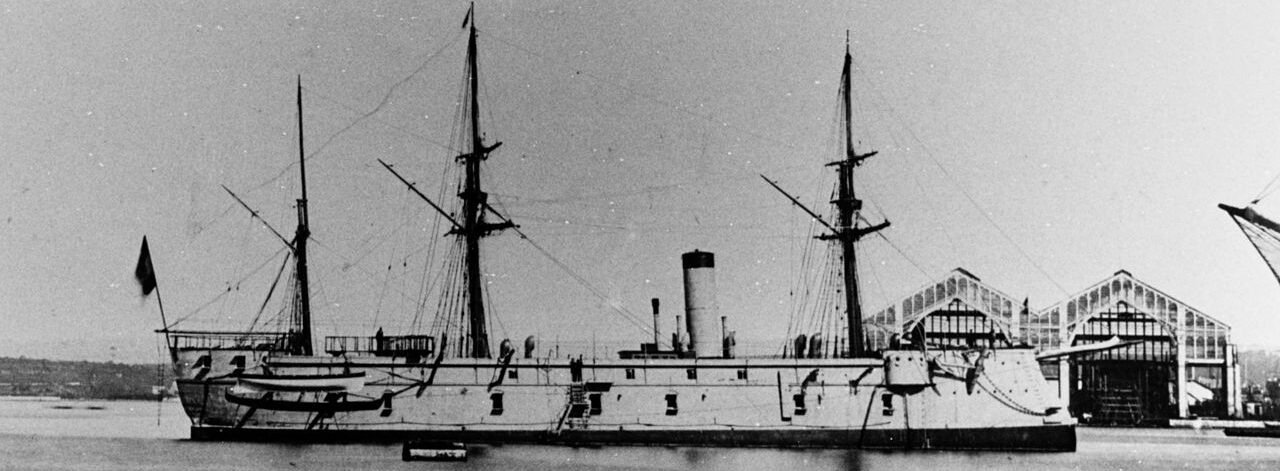
The first Austro-Hungarian Broadside ironclad
 Austro-Hungarian Navy, 1862-1883: SMS Drache, Salamander
Austro-Hungarian Navy, 1862-1883: SMS Drache, Salamander
 Austrian Fleet |
Austrian Fleet |  pre-WW1 fleet |
pre-WW1 fleet |  WW1 fleet
WW1 fleet
The Drache class ironclads (1860) were converted from Trieste-built Frigates, as a first generation of Austro-Hungarian broadside ironclads. They took part in the 1863 Battle of Lissa, modernized and maintained in service as training, then harbour defence ships until 1883. #austrohungary #austriannavy #kukkriegsmarine #austrohungariannavy #austrohungarian #drache #salamander
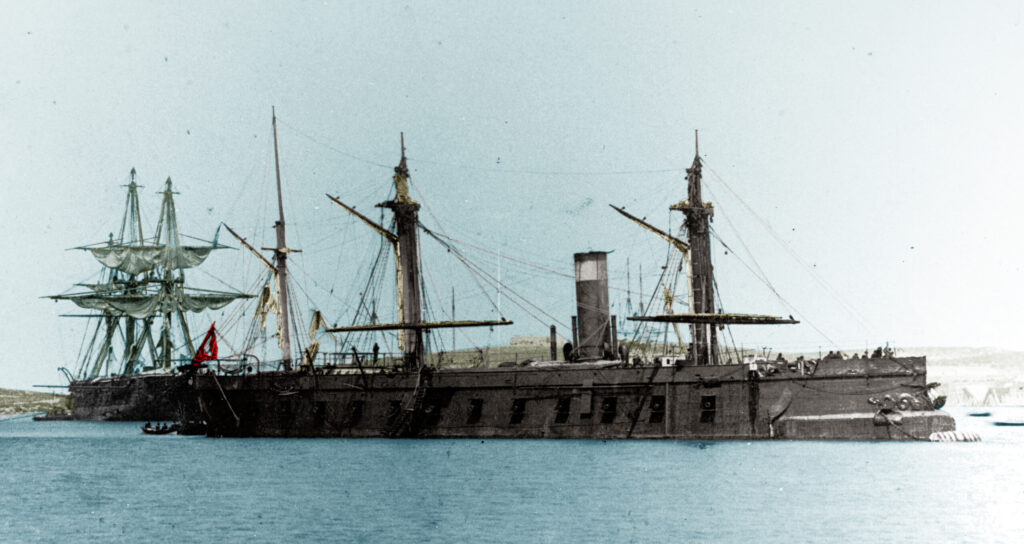
The Drache in her original state, masts partially dismantled, colorized by me.
Context: Rivalry with Italy, leading to Lissa
In the 1860s Mediterranean at large there were several naval “hot topics”. The Royal Navy wanted a power equal to rival naval powers in the region, France still looming large at least until the 1850s Criman war, and far less post-1870, but also the rising Regia Marina after its newly found independence. Spain was less of a concern, having a smaller fleet and limited presence, scattered between the Atlantic and Empire. Further to the east a rivalry also grew between the still powerful Ottoman Navy and also recently independent young Greek Kingdom.
But in the Mediterranean, there was one clear rivalry in 1861 as Italy became Independent, with the equally young Austro-Hungarian Empire, consolidated in 1867. Before that, it was Austria, which growing Navy became a threat to Italian interests in the Adriatic sea and beyond.
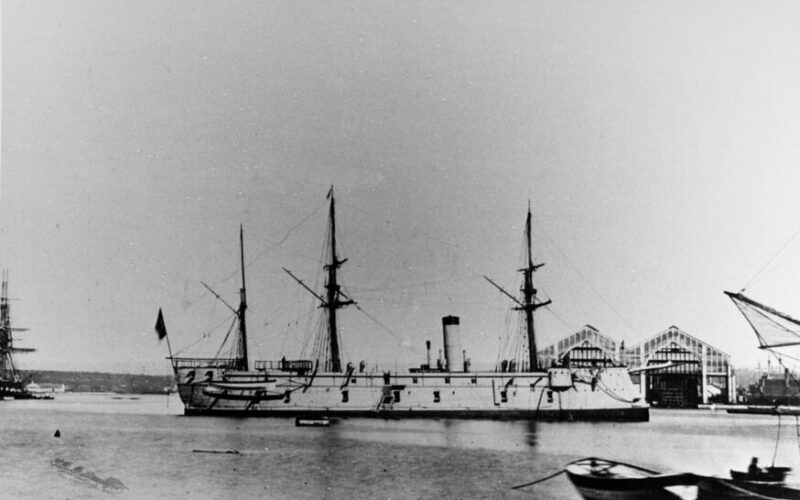
Until 1859, most Austrian ships were purchased in nearby Venice, but this soon changed as the city also changed hands. With the French Ironclad Gloire showing the way in 1859, there was a sudden race towards broadside ironclads around Europe. It was clear for Austrians present in Italy, that the former was now looking to purchase ironclads in France and the UK, and Austria soon followed suite. When it was obvious Italy ws on the same path, it was decided to convert on the spot two large frigates ordered to Trieste, Stabilimento Tecnico Triestino on February 1861 and named SMS Drache and Salamander. Wooden-built, it was relatively to clad them with iron plating overall, alongside the belt, and modify the final armament. As a result, they were launched in August and September 1861 and completed in May and November 1862, made very fast with all attention paid to, finances and workforce. Austria needed to have these before Italy in case of war. In effect, they started the Austro-Italian ironclad arms race.
The Austro-Italian ironclad arms race
⚙ The Austro-Italian naval Arms Race prior to Lissa (1864) | |
 Regia Marina Regia Marina |  KuK Kriegsmarine KuK Kriegsmarine |
|
Formidabile class 1860 Principe di Carignano class 1861 Re d'Italia class 1861 Regina Maria Pia class (1862) Roma class (1863) Affondatore (1863) Principe Amedeo class (ordered 1865) |
Drache class (1860) Kaiser Max class (1861) Erzherzog Ferdinand Max class (1863) |
Design of the class
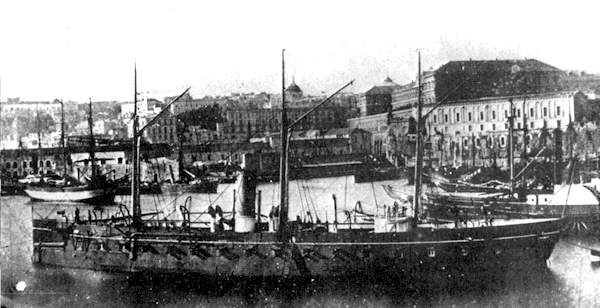
The rival French-built Terribile of the Formidabile class, which motivated their construction.
The Austrian major ironclad construction program was supervised Archduke Ferdinand Max, Marinekommandant, brother of the the emperor as an answer to Italy’s own program and news of the Formidabile-class ironclads being purchased from France in 1860. Design work was done by the Austrian Director of Naval Construction Josef von Romako. He would sign all Austrian ironclads up to SMS Tegetthoff. However these forst ships were not impressive and like the Formidabile and Gloire, rated as 3rd-class armored frigates.
Hull and general design
She was a large wooden ship, yet small for capital ship standard, being 62.78 meters (206 ft) between perpendiculars and overall length 70.1 meters (230 ft). The beam of 13.94 meters (45 ft 9 in) and draft of 6.3 to 6.8 meters depending on the load (20 ft 8 in to 22 ft 4 in) gave them buoyancy and stability, but not agility. Displacement was 2,824 long tons (2,869 t), normal load, 3,110 long tons (3,160 t), deep load. The crew comprised 346 officers and crewmen.
Armour protection layout
Their wooden hull was covered with iron armor plates riveted on top. A solution quite convenient for early and quick conversions, but this was very partial: These plates created a waterline belt 115 mm (4.5 in) in thickness. Compared to the Formidabile it was better (109 mm or 4.3 in), but weak in comparison to the Gloire, with a 120 mm (4.7 in) belt and 100 mm (3.9 in) conning tower; protecting the staff and helmsman. Plus this was early wrough iron. Over time it became worthless against modern shells.
Powerplant
Drache and her sister came out with the originally planned horizontal 2-cylinder steam engine, driving a single 4-pladed large propeller. It could not be lifted up to use sail. Steam was provided by four coal-fired boilers (probably squared, single hatch style) exhausting through a single large rounded funnel. The total output was 1,842 to 2,060 indicated horsepower (1,374 to 1,536 kW) depending on heat and pressure, and a speed of 10.5 up to 11 knots (19.4 to 20.4 km/h; 12.1 to 12.7 mph), this also varied between the two ships on trials. Poor range (probably just below 1000 nm on steam alone) meant she had three masts and was barque rigged for long range crossings, which was largely sufficent of the Adriatic. The sailing area (unknown superficy) was increased between 1869 and 1872, in order to make them quicker at all times, since the Adriatic was not an especially windy sea.
Armament
These first generation broadside ironclads were armed with ten very large 48-pounder smoothbore guns located at the center of the battery, five either side, completed by eighteen 24-pounder rifled, muzzle-loading (RML) guns, eight on either side, four fore and aft of the 48-pounder. None were present on the main deck, protected by tall bulwarks. In 1867, she ships were rearmed with ten Armstrong RML 7-inch (178 mm) guns in the same location, plus two bronze RML 2-inch (51 mm) on swivel guns on the main deck. The hulls were originally fitted with ram bows wit the same look as for the French Gloire.
⚙ specifications as built |
|
| Displacement | 2,824 tonnes standard, 3,110 tonnes full load |
| Dimensions | 70.1 x 13.94 x 6.8 m (230 ft x 45 ft 9 in x 22 ft 4 in) |
| Propulsion | 1 Shaft, RP Steam engine, 4 boilers, 2,060 ihp (1,540 kW) |
| Speed | 10.5 knots (19.4 km/h; 12.1 mph) |
| Range | Unlimited by sail, c1000 nm or less with steam |
| Armament | 10 × 48-pounder smoothbore guns, 18 × 24-pounder rifled, muzzle-loading guns |
| Protection | Waterline belt: 115 mm (4.5 in) |
| Crew | 346 |
Career of the Drache class (1862-1875)
 SMS Drache
SMS Drache
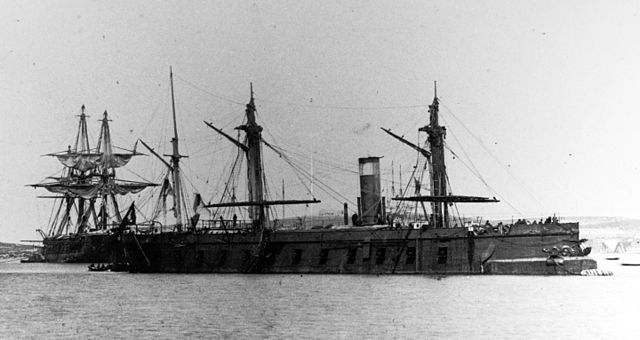
Drache was laid down on 18 February 1861, launched on 9 September 1861, completed in November 1862. After initial training, and a flet cruise in 1963, she took part with her sister to the Second Schleswig War, but by remaining in the Adriatic to protect the coastline during another squadron was sent to the North Sea to fight off Denmark with the Prussian Navy. In June 1866, Italy declared war on Austria (Third Italian War of Independence) which happened at the same time as the Austro-Prussian War. While the army was beaten badly by Prussia, the Navy was mobilized to face the expected Italian attack. Rear Admiral Wilhelm von Tegetthoff pressed on preparedness of all ships, verified they were all fully crewed and supplied before fleet exercises in Fasana. When he estimated it ready enough, he sailed to Ancona on 27 June to try to draw out the Italians on open sea, which Admiral Carlo Pellion di Persano refused.
Later this became the Battle of Lissa, when Persano initially attacked the island of Lissa on the 18th. The Italians had twelve ironclads with 3,000 troop aboard, for a landing after shelling the Austrian defenses. But the landing was repelled, and Tegetthoff, notified, sailed out on the 19th, but only arrived in the morning of 20 July as Persano was ill-prepared, trying a second landing, into three groups. Just one was in the right position to face the Austrian wege formation with his ironclads on the edge and external face. Drache was on his right flank and wooden warships protected inside and behind.
When persano was transferred to Affondatore, the gap was exploited to enter by Tegetthoff, dividing the Italian fleet. What followed wa a chaotic melee of ramming attempts and close quarter gunfire. Drache engaged the coastal ironclad Palestro with concentrated broadsides, using incendiary “hot shot” which burned her, but she withdrew. Drache swapped next on the larger ironclad Re d’Italia and with now classic projectiles, she damaged her rudder, to attempt a ramming, which was exploited by Tegetthoff, sinking her. Drache took many hits: One knocked down her mainmast. One killed her commander outright, decapitated. Captain Moll Heinrich von Mollwas replaced by XO Lt. Karl Weyprecht. A minor fire start was suppressed. She emerged relatively unscathed.
After the loss of Re d’Italia sank, the Italian fleet disengaged and Persano, which still had more ships, refused to counter-attack, being low on coal and ammunition with demoralized crews while Tegetthoff made it to Pola and a hero’s welcome. Lissa was the sold and only major engagement Drache took part in.
Her Later career was more cushy indeed. She stayed as part of the northern Adriatic fleet in patrols and by 12 August this was the Armistice of Cormons. Meanwhile Austria lost the land battle at Königgrätz. Becoming Austria-Hungary with the Ausgleich of 1867, it was force to cede Venice to Italy. The next years saw an opposition and veto from Hungary on any naval expansion, with the bulk being decommissioned and disarmed.
Later the Drache class was modernized with rifled guns, prioritized in FY1967, done in 1867–1868. However years of neglect left her in a poor state by 1875, when stricken on 13 June. A sell to China in 1883 went nowhere prior to the confrontation with France. In 1884 she was BU.
 SMS Salamander
SMS Salamander
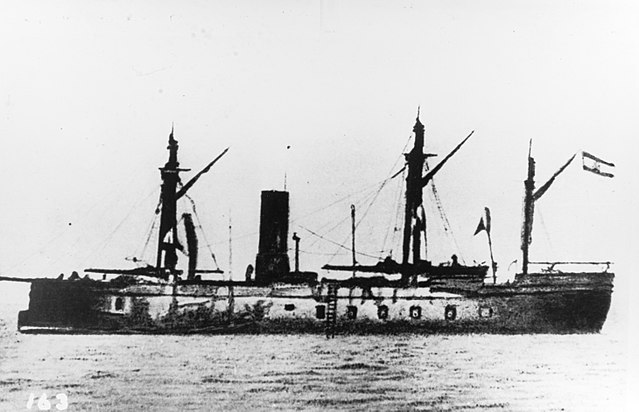
The career of Salamander was very close to her sister. They operated in pair. Salamander was laid down in February 1861, launched on 22 August 1861, completed in May 1862, six months before Drache. In the Second Schleswig War of 1864 she remained in the Adriatic. When Italy declared war on Austria she was fully mobilized by von Tegetthoff, and sailed to Ancona on 27 June, while Persano targeted instead the island of Lissa. On the 20th when Tegetthoff attacked she was at the front of the wedge-shaped formation, left flank of the admiral ship, Ferdinand Max.
Salamander and the other two ships of the left wing (Habsburg and Kaiser Max) attacked the leading Italian division (Principe di Carignano, Castelfidardo, Ancona) and a melee followedn in which Salamander attempted to ram one ironclad, which manoeuvered out (unidentified in the heavy gun smoke). After Re d’Italia was sunk, Palestro exploded after a magazine explosion, Persano broke off the engagement. Salamander returned to Pola with the fleet, having being hit by 35 shells, but had no serious damage, just shrapnel casualties.
Stationed in the northern Adriatic until the end of the war in August, she was partially disarmed after the Treaty of Vienna and Ausgleich of 1867. She was then decommissioned, and recommissioned after a modernization, refitted and rearmed in 1867–1868. But in 1875 her general state had her demoted as stationary guard ship. In 1883 her wooden hull was considered rotten and unsafe (infested with cockroaches) and she was stricken on 18 March 1883, converted into a naval mine storage hulk for ten years, until BU in 1895–1896.
Read More/Src
Books
Dislère, Paul (1877). Die Panzerschiffe der neuesten Zeit. Pola: Druck und Commissionsverlag von Carl Gerold’s Sohn.
Gardiner, Robert, ed. (1979). Conway’s All the World’s Fighting Ships 1860–1905. London: Conway Maritime Press.
Greene, Jack & Massignani, Alessandro (1998). Ironclads at War: Origin and Development 1854–1891. Da Capo Press.
Hale, John Richard (1911). Famous Sea Fights From Salamis to Tsu-shima. Little, Brown, & Company
Pawlik, Georg (2003). Des Kaisers Schwimmende Festungen: die Kasemattschiffe Österreich-Ungarns, Neuer Wissenschaftlicher Verlag.
Silverstone, Paul H. (1984). Directory of the World’s Capital Ships. New York: Hippocrene Books.
Sondhaus, Lawrence (1994). The Naval Policy of Austria-Hungary, 1867–1918. West Lafayette: Purdue University Press
Wilson, Herbert Wrigley (1896). Ironclads in Action 1855 to 1895. London: S. Low, Marston and Company.
Links
wiki Drache-class_ironclad
on alchetron.com
mateinfo.hu/ lissa
en.wikipedia-on-ipfs.org/ List_of_ships_of_Austria-Hungary


 Latest Facebook Entry -
Latest Facebook Entry -  X(Tweeter) Naval Encyclopedia's deck archive
X(Tweeter) Naval Encyclopedia's deck archive Instagram (@navalencyc)
Instagram (@navalencyc)





 French Navy
French Navy Royal Navy
Royal Navy Russian Navy
Russian Navy Armada Espanola
Armada Espanola Austrian Navy
Austrian Navy K.u.K. Kriegsmarine
K.u.K. Kriegsmarine Dansk Marine
Dansk Marine Nautiko Hellenon
Nautiko Hellenon Koninklije Marine 1870
Koninklije Marine 1870 Marinha do Brasil
Marinha do Brasil Osmanlı Donanması
Osmanlı Donanması Marina Do Peru
Marina Do Peru Marinha do Portugal
Marinha do Portugal Regia Marina 1870
Regia Marina 1870 Nihhon Kaigun 1870
Nihhon Kaigun 1870 Preußische Marine 1870
Preußische Marine 1870 Russkiy Flot 1870
Russkiy Flot 1870 Svenska marinen
Svenska marinen Søværnet
Søværnet Union Navy
Union Navy Confederate Navy
Confederate Navy Armada de Argentina
Armada de Argentina Imperial Chinese Navy
Imperial Chinese Navy Marinha do Portugal
Marinha do Portugal Mexico
Mexico Kaiserliche Marine
Kaiserliche Marine 1898 US Navy
1898 US Navy Sovietskiy Flot
Sovietskiy Flot Royal Canadian Navy
Royal Canadian Navy Royal Australian Navy
Royal Australian Navy RNZN Fleet
RNZN Fleet Chinese Navy 1937
Chinese Navy 1937 Kriegsmarine
Kriegsmarine Chilean Navy
Chilean Navy Danish Navy
Danish Navy Finnish Navy
Finnish Navy Hellenic Navy
Hellenic Navy Polish Navy
Polish Navy Romanian Navy
Romanian Navy Turkish Navy
Turkish Navy Royal Yugoslav Navy
Royal Yugoslav Navy Royal Thai Navy
Royal Thai Navy Minor Navies
Minor Navies Albania
Albania Austria
Austria Belgium
Belgium Columbia
Columbia Costa Rica
Costa Rica Cuba
Cuba Czechoslovakia
Czechoslovakia Dominican Republic
Dominican Republic Haiti
Haiti Hungary
Hungary Honduras
Honduras Estonia
Estonia Iceland
Iceland Eire
Eire Equador
Equador Iran
Iran Iraq
Iraq Latvia
Latvia Liberia
Liberia Lithuania
Lithuania Mandchukuo
Mandchukuo Morocco
Morocco Nicaragua
Nicaragua Persia
Persia San Salvador
San Salvador Sarawak
Sarawak Uruguay
Uruguay Venezuela
Venezuela Zanzibar
Zanzibar Warsaw Pact Navies
Warsaw Pact Navies Bulgaria
Bulgaria Hungary
Hungary

 Bundesmarine
Bundesmarine Dutch Navy
Dutch Navy Hellenic Navy
Hellenic Navy Marina Militare
Marina Militare Yugoslav Navy
Yugoslav Navy Chinese Navy
Chinese Navy Indian Navy
Indian Navy Indonesian Navy
Indonesian Navy JMSDF
JMSDF North Korean Navy
North Korean Navy Pakistani Navy
Pakistani Navy Philippines Navy
Philippines Navy ROKN
ROKN Rep. of Singapore Navy
Rep. of Singapore Navy Taiwanese Navy
Taiwanese Navy IDF Navy
IDF Navy Saudi Navy
Saudi Navy Royal New Zealand Navy
Royal New Zealand Navy Egyptian Navy
Egyptian Navy South African Navy
South African Navy






























 Ukrainian Navy
Ukrainian Navy dbodesign
dbodesign